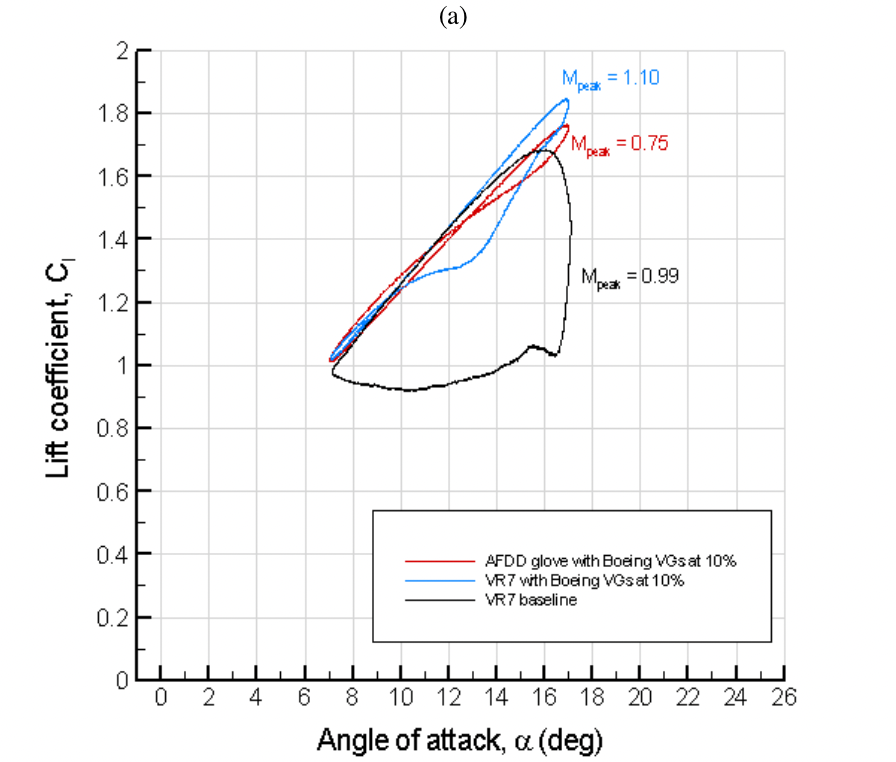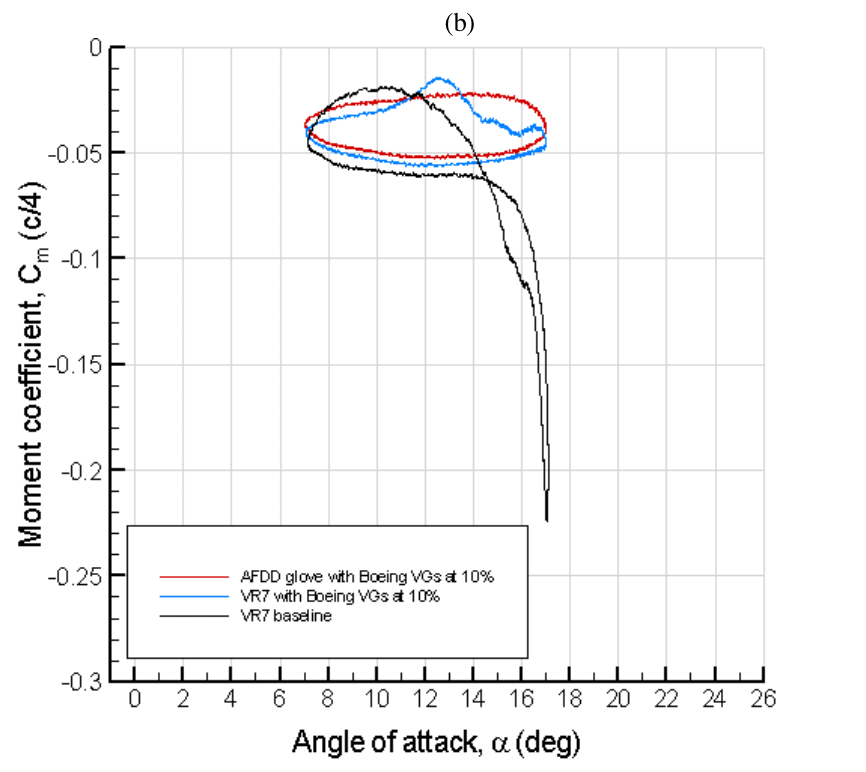Originally Posted by
SansAnhedral
The "devices" you allude to, presumably are also associated with the LE and TE mods you mentioned?
Other than local VGs, gurney tabs, TE/chord extension or profiling, or LE droop scabs - I am having a hard time imagining just what you were up to! But rather intrigued.
Preston B. Martin tried blade style, semi immersed micro VGs, and they suppressed the hysteresis, done good, but they increased drag by 50%. I discovered an odd little device when trying to avoid a transverse vortex structure, and that suppressed the hysteresis, and reduced drag.
Ref: Martin, P., Wilson, J., Berry, J., & Wong, T. (2008). Passive Control of Compressible Dynamic Stall.
26th AIAA Applied Aerodynamics Conference, 1–33.
http://scholar.google.com/scholar?hl...ynamic+Stall#0





 Ouch...
Ouch... that's 50% increase in drag, we tested 5-8% reduction
(from a NACA clean baseline) using the LE Device, and normalizing hysteresis.
The reason for the drag reduction is discernable when you look at flow structures around a rotating blade... there is this thingy called radial acceleration happening, and so when you shed a vortex structure it is quite different on a rotor to doing the same on your LERX or PA28 micro VGs... unless you are spinning at 200RPM for a rotor, or 2700 RPM for a propeller.
A blade or ramp VG on a rotor or propeller is known as a speed brake.
The TE mods are straightforward, aerodynamically, but not structurally. placing something reliably on the back edge of a rotor or propeller or fan blade on a jet engine takes... enthusiasm, and a little thinking through of the issues. NASA has been looking at how to do that since Liebeck wrote up the observations from Dan Gurney's surprise findings. They went high-tech. I went low-tech.
The effect on harmonic loads in the pitch links was spectacular, -30 to -40% in amplitudes.
A few of the most obvious happy reading documents. Dan Troolin did good work, John Lin is gifted and modest, still with NASA I believe. Cavanaugh and Myose both did nice visualizations. I didn't have software that would do a good job at that time, so had the indignity to have to take over the kitchen sink, and play under water, and then go fly the propellers and the rotors.
Prop mods are actually remarkably safe, rotor mods need some care, and the TR is definitely needing of care before flight, but is also disproportionally effective. A TE mod is easy when the TR system is a fenestron, (much relieved) or robust, UH60 style, doing it on an R-22 was not fun, but was spectacular. The R44 was a bit safer for testing.
The poster child for improvement is the V-22 prop rotor. The potential increase in capability is immense, but the increase in operational safety is like helicopters, much more important. The Ch-47 is vanilla, it is a straightforward enhancement to be done, but the will to do it wasn't with the now-departed John Shipman of AATD/Ft Eustice. So if 160th, US Army, or drivers of CH47s want more capability, gizza call.
I'm on
+1 850 200 0994
Not holding my breath; the pilots know what they need, the system manages to look after the prime contractors, and the losses accrue as a direct result. This is an open forum, I don't have any interest in helping the regime of Putin or Xi, I have interest in submarine propellers, ship propellers, aircraft propellers and rotors, as well as fan blade enhancements.
Look at the CL, CD changes of an LET, and then consider that a fan blade is a glorified fixed pitch propeller, constrained at both static and high-speed requirements. If that is not clear, consider that at sea level a fan engine has a SFC of 0.35, and at FL350, M0.80 it is 0.70.... A turbojet has 1.00 and 1.00 for the same conditions, now tell me about the efficiency of a fan blade at high speed.... and then look at the CL/CD of a LET again. We got +30% thrust in March 2013, on a JT15D-1A on static testing.... That was using a scrap engine provided by Bob Hale out of ATL, with an independent observation by the manager of the SLAC. I believe that the FL350/M0.8 solution is much more profound.
Anyway.
Lin John C. (1999). Control of Turbulent Boundary-Layer Separation using Micro-Vortx Generators.
30th AIAA Fluid Dynamics Conference.
Lee, T., & Lee, L. (2007). Effect of Gurney Flap on Unsteady Wake Vortex.
Journal of Aircraft,
44(4), 1398–1402.
https://doi.org/10.2514/1.29555
Greenwell, D. I. (2010). Gurney Flaps on Slender and Nonslender Delta Wings.
Journal of Aircraft,
47(2), 675–681.
https://doi.org/10.2514/1.46610
Bae, E. S., & York, N. (n.d.).
Rotor Stall Alleviation with Active Gurney Flap.
Nikolic, V. R. (2006). Additional Aerodynamic Features of Wing-Gurney Flap Flows.
Journal of Aircraft,
43(5), 1325–1333.
https://doi.org/10.2514/1.19596
Thesis, (2011).
AN INVESTIGATIVE STUDY OF GURNEY FLAPS ON A NACA 0036 AIRFOIL.
March.
Yee, K., Joo, W., & Lee, D.-H. (2007). Aerodynamic Performance Analysis of a Gurney Flap for Rotorcraft Application.
Journal of Aircraft,
44(3), 1003–1014.
https://doi.org/10.2514/1.26868
Papadakis, M., Myose, R. Y., & Matalw, S. (1997).
Experimental investigation of Gurney flaps on a two element general aviation airfoil Experimental Investigation of Gurney Flaps on a Two Element General Aviation Airfoil.
January.
DUMITRESCU, H., & MĂLĂEL, I. (2010). Analysis of low Reynolds number flow past Gurney flap.
INCAS Bulletin,
2(4), 97–105.
http://bulletin.incas.ro/files/horia...v2no4_full.pdf
Storms, Bruce L (Sterling Software, Moffett Field, C. 94035), & Jang, Cory S (California Polytechnic State University, San Luis Obispo, C. 93407 E. (1993). Lift enhancement of an airfoil using a Gurney flap and vortex generators.
Journal of Aircraft,
31(3), 542–547.
http://pdf.aiaa.org/jaPreview/JA/1994/PVJAPRE46528.pdf
Matalanis, C. G., & Eaton, J. K. (2007). Wake vortex control using static segmented Gurney flaps.
AIAA Journal,
2(2), 321–328.
http://pdf.aiaa.org/jaPreview/AIAAJ/2007/PVJA25956.pdf
Rhee, M. (2004). A Computational Study of an Oscillating VR-12 Airfoil with a Gurney Flap.
22nd AIAA Applied Aerodynamics Conference and Exhibit,
August.
Jeffrey, D., Zhang, X., & Hurst, D. (2000). Aerodynamics of Gurney Flaps on a Single-Element High-Lift Wing.
Journal of Aircraft,
37(2).
http://arc.aiaa.org/doi/pdf/10.2514/2.2593
Traub, L. W., & Freienmuth, E. O. (2011). Effect of Streamwise Attachment Gap on Aerodynamic Characteristics of Gurney Flaps.
Journal of Aircraft,
48(1), 348–352.
https://doi.org/10.2514/1.C031226
Li, Y., Wang, J., & Zhang, P. (2003).
Influences of Mounting Angles and Locations on the Effects of Gurney Flaps Introduction.
40(3).
Traub, L. W., & Galls, S. F. (1999).
Effects of Leading- and Trailing-Edge Gurney Flaps on a Delta Wing Introduction.
36(4).
Troolin, D. (2009).
A quantitative study of the lift-enhancing flow field generated by an airfoil with a Gurney flap.
December.
Cavanaugh, M. A., Tech, V., & Mason, W. H. (n.d.). Wind Tunnel Test of Gurney Flaps and T-Strips on an NACA 23012 Wing.
Test, 1–18.
Myose, R., Lietsche, J., Scholz, D., Zingel, H., Hayashibara, S., & Heron, I. (2006). Flow Visualization Study on the Effect of a Gurney Flap in a Low Reynolds Number Compressor Cascade.
6th AIAA Aviation Technology, Integration and Operations (ATIO) 25-27 September 2006,
September, 25–27.
http://arc.aiaa.org/doi/pdf/10.2514/6.2006-7809